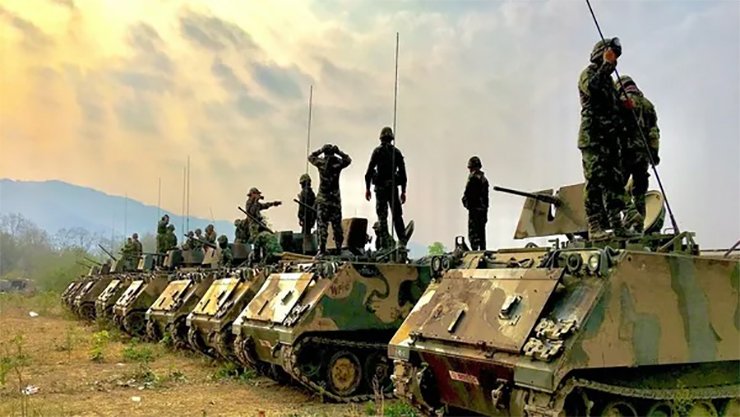India is one of the world’s largest importers of defence equipment. India’s quest for self-reliance in defence has acquired a new dimension and urgency amid the threatening postures of some of our neighbours and emerging geo-political tensions. There are new challenges and uncertainties, adding urgency to indigenous efforts.
First of all, the defence expenditure. India spends approximately US$75 billion (Rs 6.8 lakh crore) on defence annually, much less than some of our neighbours. According to estimates, Chinese defence expenditure is around US$700 billion annually. While imposing a 104% (now 125%) tariff on China, US President Donald Trump said China has a massive surplus and invests that extra money in the military. While the higher tariff was paused for most countries for 90 days, it continues for China. In the current geopolitical turmoil, the need and urgency is heightened.
The Government has taken several measures in the recent past:
- ‘Make in India’ Campaign: India’s defence production has risen phenomenally under the ‘Make in India’ initiative, reaching a record ₹1.27 lakh crore in FY 2023-24, a 174% rise since 2014-15. Defence exports hit a record ₹21,083 crore in FY 2023-24, expanding 30 times over a decade, with exports to more than 100 countries. There has been a surge in the defence budget, from ₹2.53 lakh crore in 2013-14 to ₹6.81 lakh crore in 2025-26.
- Positive Indigenisation Lists: The Ministry of Defence has released multiple ‘Positive Indigenisation Lists’ that specify timelines for indigenisation of certain defence items. This policy push encourages domestic industries to design, develop, and manufacture these items. For example, components for the K9 Vajra artillery systems and LCA Tejas aircraft are now indigenised due to these lists.
- Innovations for Defence Excellence (iDEX): This scheme aims to foster innovation and technology development in defence by engaging startups and MSMEs. iDEX provides funding, mentorship, and market access to promising technologies. Over 200 startups have been selected, leading to the development of numerous strategic technologies. The scheme has allocated ₹449.62 crore for 2025-26, engaging with over 600 startups and MSMEs, resulting in over 430 contracts signed as of February 2025.
- Defence Industrial Corridors: The establishment of Defence Industrial Corridors in UP and Tamil Nadu aims to create ecosystems for defence manufacturing by providing necessary infrastructure, attracting investment, and facilitating the growth of the defence industrial base.
- Technology Development Fund (TDF) Scheme: Executed by the Defence Research and Development Organisation (DRDO), this scheme provides funding support (up to 90% of the total project cost, up to ₹50 crore) to industries, especially MSMEs and startups.
- Simplifying Acquisition Procedures: The Defence Acquisition Procedure (DAP) 2020 and subsequent reforms aim to streamline procurement processes, prioritise indigenous development, and reduce delays in acquiring defence equipment. The Ministry of Defence has declared 2025 as the ‘Year of Reforms’ for simplifying acquisition and promoting public-private partnerships.
- Increased FDI in Defence: The government has increased the Foreign Direct Investment (FDI) limit in defence manufacturing under the automatic route to 74%, higher also permissible under the approval route.
The Defence Ministry has released multiple ‘Positive Indigenisation Lists’ that specify timelines for indigenisation of certain defence items, encouraging domestic industries to design, develop, and manufacture these items. For instance, components for the K9 Vajra artillery systems and LCA Tejas aircraft are now indigenised due to these lists
India’s Public Sector Undertakings: These have historically played a stellar role in India’s defence production.
- Hindustan Aeronautics Limited (HAL): HAL is central to India’s aerospace sector, involved in developing aircraft like the LCA Tejas, Advanced Light Helicopter (ALH), and Light Combat Helicopter (LCH) Prachand. It included the procurement of 156 LCH Prachand helicopters for defence, with over 65% indigenous content. HAL is also involved in space missions.
- Bharat Electronics Limited (BEL): BEL is supplying advanced Electronic Warfare (EW) Suites on Mi-17 V5 helicopters operated by the IAF. It also developed a Coastal Surveillance System for India’s 7500 km long coastline. BEL is developing radars with the induction of a Weapon Locating Radar and 3D Tactical Control Radar.
- Bharat Dynamics Limited (BDL): BDL is a key player in missile and underwater weapons production, contributing to India’s missile programmes like Akash and Varunastra.
- Ordnance Factory Board (OFB) Restructuring: The erstwhile Ordnance Factory Board has been reorganised into seven new Defence Public Sector Undertakings to enhance efficiency and specialisation.

India’s Private Sector: An Emerging Force in Defence Manufacturing
The private sector is increasingly becoming a significant contributor to India’s defence capabilities:
- Adani Defence & Aerospace: A part of Adani Group is becoming a hub for hi-tech defence manufacturing, fighter aircraft, unmanned aerial systems including drones, ammunition, helicopters, missiles, small arms and ammunition, counter-drone systems, air-defence systems, avionics and systems, opto-electronics, aerostructure and precision components, aerospace composites, radar and electronic warfare systems, cyber defence and intelligence, surveillance and reconnaissance (ISR) technologies.
- Tata Advanced Systems Limited (TASL): TASL is involved in various defence projects, including building the first assembly line in India for the Airbus C295 military transport aircraft in partnership with Airbus Defence and Space. The first ‘Made in India’ C-295 is expected to roll out in September 2026.
- Larsen & Toubro (L&T): L&T is a major private sector player in defence, involved in shipbuilding, and artillery systems (like the Close-in Weapon System (CIWS) and High-Power Radar (HPR). L&T is also a key partner in the production of the Advanced Towed Artillery Gun System (ATAGS).
- Bharat Forge: Bharat Forge is actively involved in the manufacturing of artillery guns, including the 155mm/52 calibre ATAGS, and other defence components.
- MSMEs and Startups: A large number of MSMEs and startups have come up with iDEX and the Defence Industrial Corridors. The private sector’s contribution to total defence production reached 21% in FY24, amounting to ₹26,506 crore, accounting for 60% of India’s defence exports.
iDEX provides funding, mentorship, and market access to promising technologies. Over 200 startups have been selected, leading to the development of numerous strategic technologies. The scheme has allocated ₹449.62 crore for 2025-26, engaging with over 600 startups and MSMEs, resulting in over 430 contracts signed as of February 2025
Progress towards Aatmanirbharta in Air, Land, and Naval Needs
- Air Force: IAF is undergoing significant modernisation with indigenous aircraft. The LCA Tejas programme is a prime example, with orders for Tejas Mk-1 and Mk-1A aircraft and plans for the more advanced Tejas Mk-2. The development of the Advanced Medium Combat Aircraft (AMCA), a fifth-generation stealth fighter, is also underway. The IAF aims to increase aircraft production to 35-40 per year, with increased participation from the private sector. While considering strategic acquisitions like the Rafale and potentially the F-35 as a stopgap, the long-term focus is on home-grown systems. The IAF aims to have a fleet of 60 squadrons (approximately 1000 combat jets) by 2047.
- Land Forces (Army):The Indian Army is focusing on modernising its artillery, armoured vehicles, and soldier systems. Indigenous development and procurement of artillery guns like the ATAGS, main battle tanks like the Arjun Mk-1A (with efforts to indigenise its engine), and various missile systems are key priorities. The Army is also leveraging the iDEX scheme to induct innovative technologies developed by startups and MSMEs.
- Naval Forces (Navy):The Indian Navy is committed to expanding its fleet with indigenously built warships and submarines. Key projects include the construction of aircraft carriers like INS Vikrant, destroyers, frigates, corvettes, and submarines (both conventional and nuclear-powered), with a focus on indigenous platforms, systems, sensors, and weapons. As of January 2025, the Navy had 64 vessels under construction in India. The Navy plans to have 155-160 warships by 2030 and 175-200 by 2035. The focus is also on nuclear-powered submarines (SSNs) and underwater drones to enhance maritime capabilities.
- Artificial Intelligence: India has been steadily integrating artificial intelligence into its defence strategy. Defence has established a task force for AI in national security. The Indian Army had also set up a Quantum Lab and AI Centre. The Indian Navy also formed an AI Core group and a Centre of Excellence for AI and Big Data analysis at INS Valsura. The government also launched the Defence Artificial Intelligence Council and the Defence AI Project Agency. These initiatives aim to boost intelligence collection, surveillance, and autonomous operations. AI is designed to ensure the integration of reliable emerging technology into critical defence operations. It is used for both supporting functions, like intelligence surveillance, and navigation and offensive functions like selecting targets, drone swarms, AI-driven hacking etc. and studying cyber-attacks and protective strategies.
The Indian Air Force is undergoing significant modernisation with indigenous aircraft. The development of the Advanced Medium Combat Aircraft (AMCA), a fifth-generation stealth fighter, is underway. The IAF plans to increase aircraft production to 35-40 per year, with increased participation from the private sector, to have approximately 1000 combat jets by 2047
Achievements and Future Outlook
The concerted efforts of the government, DPSUs, and the private sector, coupled with a strong focus on R&D and technology transfer, are steadily propelling India towards greater self-reliance in defence. While challenges remain, the momentum and policy support indicate a promising trajectory for Aatmanirbharta in the Indian defence sector, contributing significantly to national security and economic growth.






